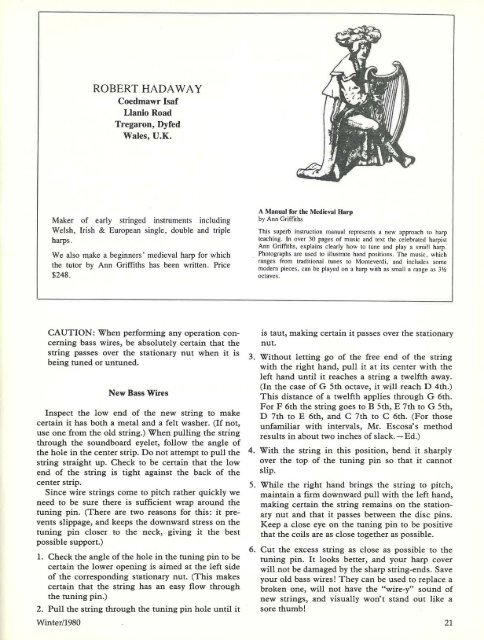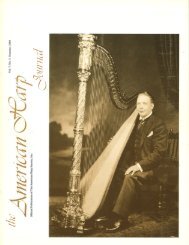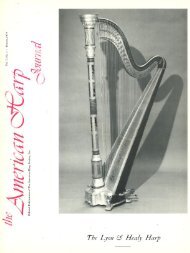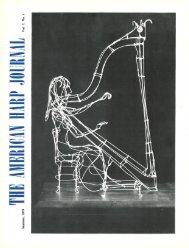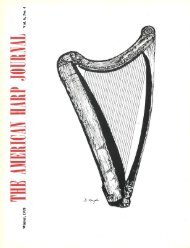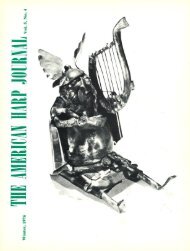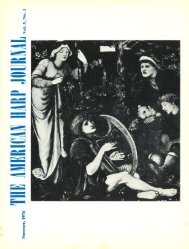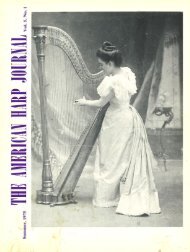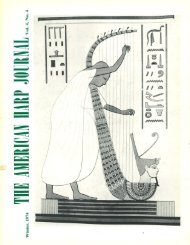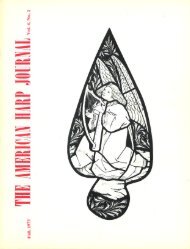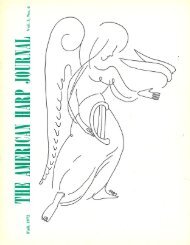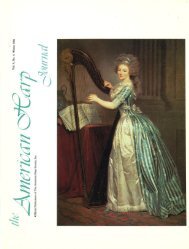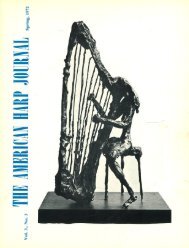You also want an ePaper? Increase the reach of your titles
YUMPU automatically turns print PDFs into web optimized ePapers that Google loves.
ROBERT HADAWAY<br />
Coedmawr lsaf<br />
Llanio Road<br />
Tregaron, Dyfed<br />
Wales, U.K.<br />
Maker of early stringed instruments including<br />
Welsh, Irish & European single, double and triple<br />
harps.<br />
We also m_ake a beginners' medieval harp for which<br />
the tutor by Ann Griffiths has been written. Price<br />
$248.<br />
A Manual for the Medieval Harp<br />
by Ann Griffiths<br />
This superb instruction manual represents a new approach to harp<br />
teaching. In over 30 pages of music and text the celebrated harpist<br />
Ann Griffiths, explains clearly how to tune and play a small harp.<br />
Photographs are used to illustrate hand positions. The music, which<br />
ranges from traditional tunes to Monteverdi, and includes some<br />
modem pieces, can be played on a harp with as small a range as 3'/2<br />
octaves.<br />
CAUTION: When performing any operation concerning<br />
bass wires, be absolutely certain that the<br />
string passes over the stationary nut when it is<br />
being tuned or untuned.<br />
New Bass Wires<br />
Inspect the low end of the new string to make<br />
certain it has both a metal and a felt washer. (If not,<br />
use one from the old string.) When pulling the string<br />
through the soundboard eyelet, follow the angle of<br />
the hole in the center strip. Do not attempt to pull the 4-<br />
string straight up. Check to be certain that the low<br />
end of the string is tight against the back of the<br />
center strip.<br />
Since wire strings come to pitch rather quickly we<br />
need to be sure there is sufficient wrap around the<br />
tuning pin. (There are two reasons for this: it prevents<br />
slippage, and keeps the downward stress on the<br />
tuning pin closer to the neck, giving it the best<br />
possible support.)<br />
1. Check the angle of the hole in the tuning pin to be<br />
certain the lower opening is aimed at the left side<br />
of the corresponding stationary nut. (This makes<br />
certain that the string has an easy flow through<br />
the tuning pin.)<br />
2. Pull the string through the tuning pin hole until it<br />
<strong>Winter</strong>/<strong>1980</strong><br />
is taut, making certain it passes over the stationary<br />
nut.<br />
3. Without letting go of the free end of the string<br />
with the right hand, pull it at its center with the<br />
left hand until it reaches a string a twelfth away.<br />
(In the case of G 5th octave, it will reach D 4th.)<br />
This distance of a twelfth applies through G 6th.<br />
For F 6th the string goes to B 5th, E 7th to G 5th,<br />
D 7th to E 6th, and C 7th to C 6th. (For those<br />
unfamiliar with intervals, Mr. Escosa's method<br />
results in about two inches of slack. - Ed.)<br />
With the string in this position, bend it sharply<br />
over the top of the tuning pin so that it cannot<br />
slip.<br />
5. While the right hand brings the string to pitch,<br />
maintain a firm downward pull with the left hand,<br />
making certain the string remains on the stationary<br />
nut and that it passes between the disc pins.<br />
Keep a close eye on the tuning pin to be positive<br />
that the coils are as close together as possible.<br />
6. Cut the excess string as close as possible to the<br />
tuning pin. It looks better, and your harp cover<br />
will not be damaged by the sharp string-ends. Save<br />
your old bass wires! They can be used to replace a<br />
broken one, will not have the "wire-y" sound of<br />
new strings, and visually won't stand out like a<br />
sore thumb!<br />
21


